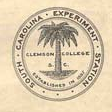The Libraries of South Carolina
by Mary Frayser
Page 33
|

|
| |
(Click on image
to view scanned
image
of Mary Frayser's booklet) |
Instances have been reported in counties without county-wide library service of provision by club
women of boxes of books for rural school use. Such gifts constitute a generous gesture but do
not adequately meet the needs. Arrangement for the transfer of the books lent after a few months,
or at the end of the school year, to another school would make possible their more efficient use.
If the loan collection is not large, the books will be read by those who desire to read them within
a school year or less time.
The need for libraries in South Carolina was never greater than today. Among the factors
inducing a greater demand for free books are shorter hours of work with more hours of leisure;
enforced leisure due to unemployment; more students in secondary schools and a better educated
people who require more reading material; recognition of the desirability of books suited to the
ages, tastes, grade needs, and reading abilities of elementary school children; the reading needs
of high school students; the book need of adults pursuing educational studies (it is estimated that
there are five such adults to every candidate for a college degree in the United States);
and the more general recognition of the wisdom of providing reading matter for every age and
interest.
Among the specific library needs of South Carolina are:
- A tax-supported public library system organized on a countywide basis in every county in South
Carolina with sufficient income to operate efficient systems of free distribution to every person
within the area of support.
- The recognition of libraries as educational agencies which cannot fulfil their mission in the
educational system of the state until, like schools, they receive state aid based on population.
- An active state library board, to lead in library development. The activities planned by the
state library board await a state appropriation in order that they be initiated.
- An experienced state field library worker to serve under the direction of the state library
board. The libraries of the state would benefit greatly from the service provided by professional
supervision.
- A school library supervisor attached to the state department of education to give assistance in
the establishment of school libraries, and to work in close cooperation with the state public
library field worker.
- Trained library service for every library.
- Provision for untrained librarians in charge of libraries to take short courses in library
training in accredited summer training schools.
- Complete unification of public school library and public library interests and close cooperation
between these two.
- A more equitable distribution of the public money spent for educational purposes based upon a
study of the needs of schools, colleges libraries, and other educational institutions and agencies
which usually receive state support


